Toyota Sienna Service Manual: Vehicle Speed Sensor "A"

DESCRIPTION
The speed sensor detects the wheel speed and sends the appropriate signals to the skid control ECU.
The skid control ECU converts these wheel speed signals into a 4-pulse signal and outputs it to the ECM via the combination meter. The ECM determines the vehicle speed based on the frequency of these pulse signals.
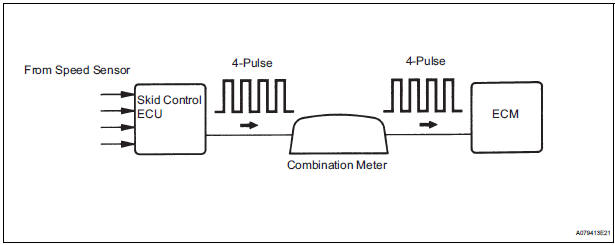

MONITOR DESCRIPTION
The ECM assumes that the vehicle is being driven when the transmission counter gear indicates more than 300 rpm and over 30 seconds have passed since the park / neutral position switch was turned OFF.
If thre is no signal from the vehicle speed sensor with these conditions satisfied, the ECM concludes that the vehicle speed sensor is malfunctioning. The ECM will turn on the MIL and a DTC will be set.
MONITOR STRATEGY

TYPICAL ENABLING CONDITIONS

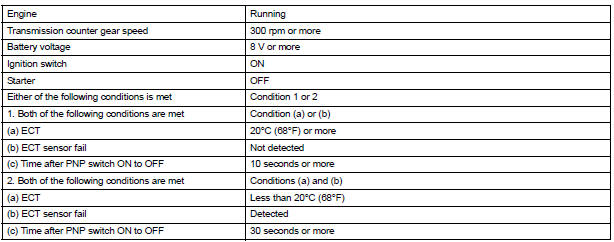
TYPICAL MALFUNCTION THRESHOLDS

WIRING DIAGRAM
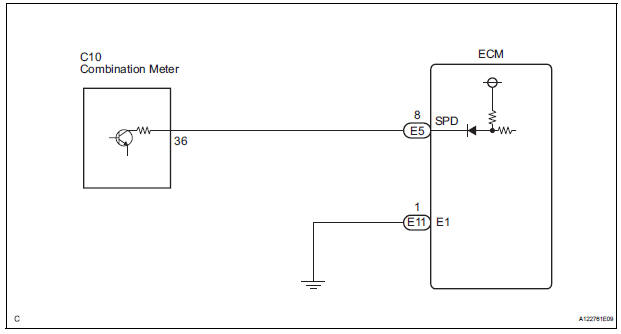
INSPECTION PROCEDURE
HINT:
Read freeze frame data using the intelligent tester. The ECM records vehicle and driving condition information as freeze frame data the moment a DTC is stored. When troubleshooting, freeze frame data can be helpful in determining whether the vehicle was running or stopped, whether the engine was warmed up or not, whether the air-fuel ratio was lean or rich, as well as other data recorded at the time of a malfunction.
1 CHECK SPEEDOMETER
(a) Drive the vehicle and check whether the operation of the speedometer in the combination meter is normal.
HINT:
- The vehicle speed sensor is operating normally if the speedometer reading is normal.
- If the speedometer does not operate, check it by following the procedure described in speedometer malfunction.


2 READ VALUE OF INTELLIGENT TESTER (VEHICLE SPEED)
(a) Connect the intelligent tester to the DLC3.
(b) Turn the ignition switch to the ON position.
(c) Turn the tester on.
(d) Select the following menu items: DIAGNOSIS / ENHANCED OBD II / DATA LIST / PRIMARY / VEHICLE SPD.
(e) Drive the vehicle.
(f) Read the value displayed on the tester.
OK: Vehicle speeds displayed on tester and speedometer display are equal.


3 CHECK COMBINATION METER ASSEMBLY (+S VOLTAGE)
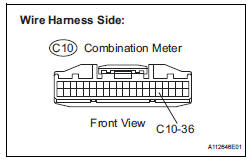
(a) Disconnect the C10 combination meter connector.
(b) Turn the ignition switch to the ON position.
(c) Measure the voltage between the terminal of the combination meter and body ground.
Standard voltage 
(d) Reconnect the combination meter connector.


4 CHECK COMBINATION METER ASSEMBLY (SPD SIGNAL WAVEFORM)
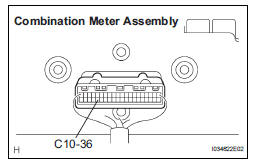
(a) Shift the transmission gear selector lever to the neutral position.
(b) Jack up the vehicle.
(c) Turn the ignition switch to the ON position.
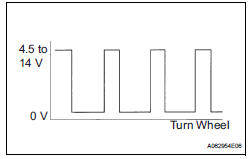
(d) Measure the voltage between the terminal of the combination meter and body ground while the wheel is turned slowly.
Standard voltage 
HINT:
The output voltage should fluctuate up and down, similarly to the diagram, when the wheel is turned slowly.


5 CHECK HARNESS AND CONNECTOR (COMBINATION METER ASSEMBLY - ECM)
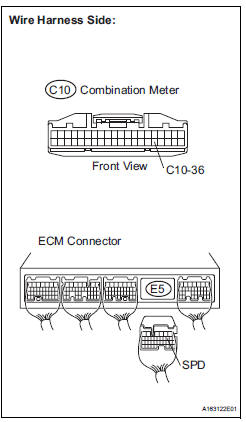
(a) Disconnect the C10 combination meter connector.
(b) Disconnect the E5 ECM connector.
(c) Measure the resistance.
Standard resistance (Check for open)

Standard resistance (Check for short)

(d) Reconnect the combination meter connector.
(e) Reconnect the ECM connector.


REPLACE ECM (See page ES-498)
 Evaporative Emission Control System Leak Detected
Evaporative Emission Control System Leak Detected
DTC SUMMARY
DESCRIPTION
The circuit description can be found in the EVAP (Evaporative Emission)
System (See page ES-409).
INSPECTION PROCEDURE
Refer to the EVAP System (See page ES-412).
...
 Brake Switch
Brake Switch
DESCRIPTION
The stop light switch is a duplex system that transmits two signals: STP and
ST1-. These two signals are
used by the ECM to monitor whether or not the brake system is working prope ...
Other materials:
Brake System Malfunction
DTC P1578 Brake System Malfunction
DESCRIPTION
This DTC is output when the VSC system has a problem. Check the VSC system
when this DTC is
output
DTC No.
DTC Detection Condition
Trouble Area
P1578
The ECM receives a brake system error signal for 0.2
...
Problem symptoms table
ENTIRE SYSTEM
METER GAUGES
WARNING LIGHTS
INDICATOR LIGHTS
BUZZER
ACCESSORY METER ASSEMBLY
...
Power back door main switch
INSPECTION
1. INSPECT POWER BACK DOOR MAIN SWITCH
Inspect the resistance of the main switch.
Resistance
If the result is not as specified, replace the switch.
Apply battery voltage and check the illuminates.
OK
HINT:
Whether the switch illuminates or not will not affect
th ...
